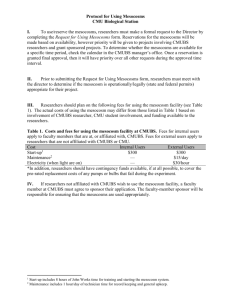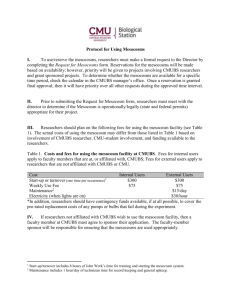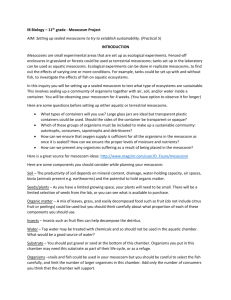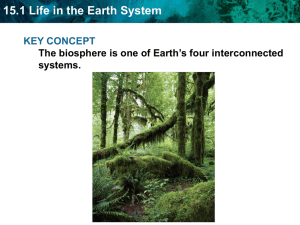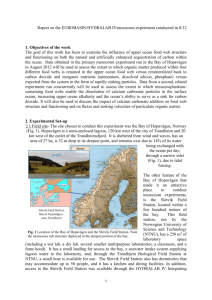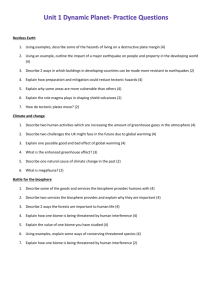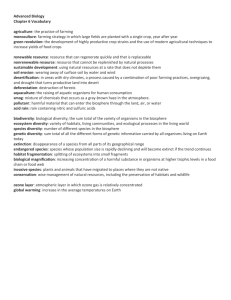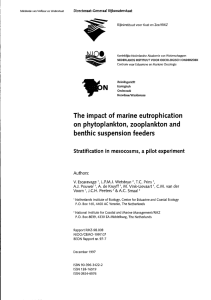a word document
advertisement
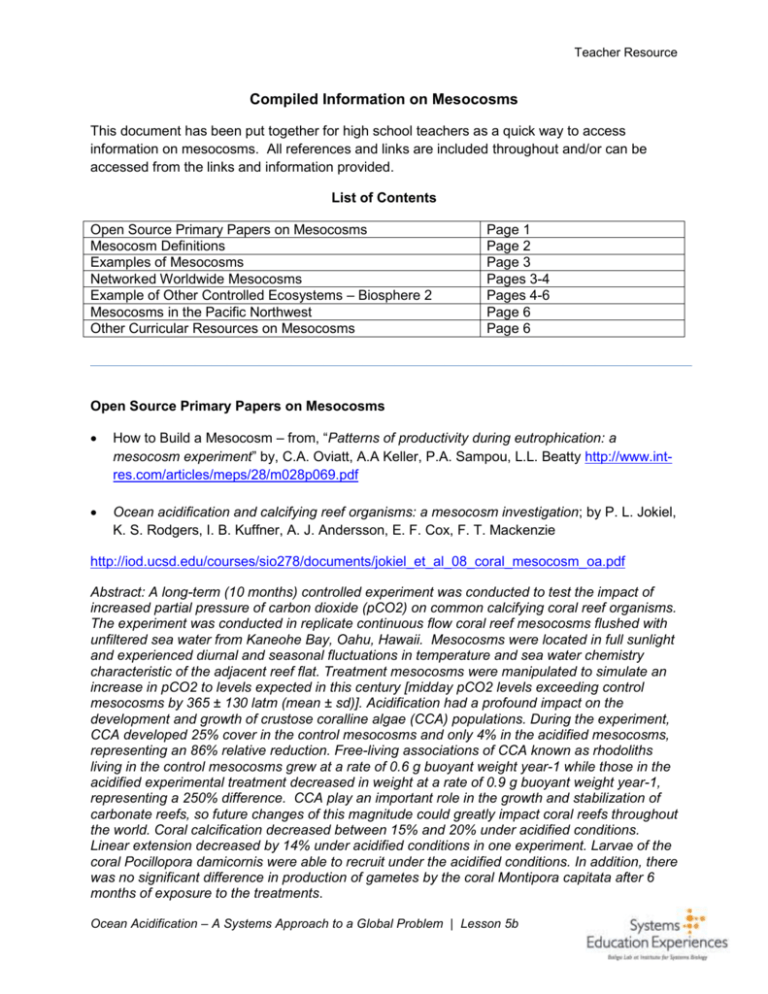
Teacher Resource Compiled Information on Mesocosms This document has been put together for high school teachers as a quick way to access information on mesocosms. All references and links are included throughout and/or can be accessed from the links and information provided. List of Contents Open Source Primary Papers on Mesocosms Mesocosm Definitions Examples of Mesocosms Networked Worldwide Mesocosms Example of Other Controlled Ecosystems – Biosphere 2 Mesocosms in the Pacific Northwest Other Curricular Resources on Mesocosms Page 1 Page 2 Page 3 Pages 3-4 Pages 4-6 Page 6 Page 6 Open Source Primary Papers on Mesocosms How to Build a Mesocosm – from, “Patterns of productivity during eutrophication: a mesocosm experiment” by, C.A. Oviatt, A.A Keller, P.A. Sampou, L.L. Beatty http://www.intres.com/articles/meps/28/m028p069.pdf Ocean acidification and calcifying reef organisms: a mesocosm investigation; by P. L. Jokiel, K. S. Rodgers, I. B. Kuffner, A. J. Andersson, E. F. Cox, F. T. Mackenzie http://iod.ucsd.edu/courses/sio278/documents/jokiel_et_al_08_coral_mesocosm_oa.pdf Abstract: A long-term (10 months) controlled experiment was conducted to test the impact of increased partial pressure of carbon dioxide (pCO2) on common calcifying coral reef organisms. The experiment was conducted in replicate continuous flow coral reef mesocosms flushed with unfiltered sea water from Kaneohe Bay, Oahu, Hawaii. Mesocosms were located in full sunlight and experienced diurnal and seasonal fluctuations in temperature and sea water chemistry characteristic of the adjacent reef flat. Treatment mesocosms were manipulated to simulate an increase in pCO2 to levels expected in this century [midday pCO2 levels exceeding control mesocosms by 365 ± 130 latm (mean ± sd)]. Acidification had a profound impact on the development and growth of crustose coralline algae (CCA) populations. During the experiment, CCA developed 25% cover in the control mesocosms and only 4% in the acidified mesocosms, representing an 86% relative reduction. Free-living associations of CCA known as rhodoliths living in the control mesocosms grew at a rate of 0.6 g buoyant weight year-1 while those in the acidified experimental treatment decreased in weight at a rate of 0.9 g buoyant weight year-1, representing a 250% difference. CCA play an important role in the growth and stabilization of carbonate reefs, so future changes of this magnitude could greatly impact coral reefs throughout the world. Coral calcification decreased between 15% and 20% under acidified conditions. Linear extension decreased by 14% under acidified conditions in one experiment. Larvae of the coral Pocillopora damicornis were able to recruit under the acidified conditions. In addition, there was no significant difference in production of gametes by the coral Montipora capitata after 6 months of exposure to the treatments. Ocean Acidification – A Systems Approach to a Global Problem | Lesson 5b Teacher Resource Mesocosm – From Wikipedia, the free encyclopedia A mesocosm is an experimental tool that brings a small part of the natural environment under controlled conditions. In this way mesocosms provide a link between observational field studies that take place in natural environments, but without replication, and controlled laboratory experiments that may take place under somewhat unnatural conditions [1]. When pursuing a laboratory experiment, the experimenter cannot account for every possible factor that would normally occur in the original environment. Mesocosms circumvent this problem as the experiment is performed in the natural environment, but in an enclosure that is small enough that key variables can be brought under control. Mesocosms have been used to evaluate how organisms or communities might react to environmental change, through deliberate manipulation of environmental variables, such as increased temperature, carbon dioxide or pH levels [2]. The advantage to mesocosm studies provides us with what we already know and what possible influential factors will produce a positive or negative reaction of our subject areas of interest. Manipulating something can give us an idea as to what to expect if something were to occur in that ecosystem or environment. [2] For indoor mesocosms, growth chambers allow us to control the experiment.[2] You can place plants in a growth chamber and manipulate the air, temperature, heat and light distribution and observe the effects when exposed to different amounts of each factor. [2] Greenhouses also contribute to mesocosm studies although sometimes, it may induce climate change, interfering with the experiment and resulting in inefficient data. From MESOCOSM – A portal of information on mesocosm facilities worldwide http://mesocosm.eu/node/16 What is a mesocosm? Aquatic mesocosms, or experimental water enclosures, are designed to provide a limited body of water with close to natural conditions, in which environmental factors can be realistically manipulated. Such mesocosms provide a powerful tool to link between in situ but often only correlative field studies on the one side, and small-scale far from natural laboratory experiments including a single or a few species only, on the other side. Thus mesocosm studies have the advantage compared to laboratory approaches that it maintains a natural community under close to natural conditions, taking into account relevant aspects from ‘the real world’ such as indirect effects, biological compensation and recovery, and ecosystem resilience. The mesocosm approach is therefore often considered to be the experimental ecosystem closest to the real world, without losing the advantage of reliable reference conditions and replication. By integrating over multiple direct and indirect species effects up or down the food web, the responses obtained from mesocosm studies can be used for parameterization in Ocean Acidification – A Systems Approach to a Global Problem | Lesson 5b Teacher Resource ecosystem and biogeochemical models. See a short video about mesocosm experiments. http://www.youtube.com/watch?v=2hmKf5v_LLM&NR=1 “Experiments on Many Scales,” Dr. Richard Feeley's Slide http://www.slideshare.net/emmettoconnell/richard-feeley-presentation-on-oceanacidification USGS SHARQ (submersible habitat for analyzing reef quality) website: http://sofia.usgs.gov/publications/ofr/00-166/ Home page of the European Mesocosms research network – http://mesocosm.eu/ See the “About MESOCOSM” page with links to the different research centers. The Bergen station link has a nice short video about mesocosms (http://mesocosm.eu/about). Ocean Acidification – A Systems Approach to a Global Problem | Lesson 5b Teacher Resource Is it possible to replicate the Earth’s complexities in an experiment? Biosphere 2 – From Wikipedia, the free encyclopedia (Jump to: navigation, search to enter Coordinates. Click the blue globe to open an interactive map. Coordinates: 32°34′43.60″N 110°51′02.14″W / 32.578778°N 110.8505944°W / 32.578778; -110.8505944) Biosphere 2 is an Earth Systems Science research facility owned by the University of Arizona. Its current mission is to serve as a center for research, outreach, teaching and lifelong learning about Earth, its living systems, and its place in the universe. It is a 3.14-acre (12,700 m2)[1] structure originally built to be an artificial, materially closed ecological system in Oracle, Arizona (US) by Space Biosphere Ventures, a joint venture whose principal officers were John P. Allen, Ocean Acidification – A Systems Approach to a Global Problem | Lesson 5b Teacher Resource inventor and Executive Director, and Margret Augustine, CEO. Constructed between 1987 and 1991, it was used to explore the complex web of interactions within life systems in a structure that included five areas based on biomes and an agricultural area and human living/working space to study the interactions between humans, farming and technology with the rest of nature.[2] It also explored the possible use of closed biospheres in space colonization, and allowed the study and manipulation of a biosphere without harming Earth's. The name comes from Earth's biosphere, Biosphere 1. Earth's life system is the only biosphere currently known. Funding for the project came primarily from the joint venture's financial partner, Ed Bass' Decisions Investment, and cost $200 million from 1985 to 2007, including land, support research greenhouses, test module and staff facilities. Biosphere 2, Oracle, AZ Biosphere 2, Ocean and Coral Reef Ocean Acidification – A Systems Approach to a Global Problem | Lesson 5b Teacher Resource 10 Lessons from Biosphere 2, By David L. Chandler http://www.wired.com/wired/archive/12.12/biosphere.html It could be the next hit reality TV show: eight people locked for two years inside a $200 million, 3-acre greenhouse, the world's largest self-sustaining ecosystem. In fact, it was Biosphere 2, the audacious 1991 experiment that became an object of ridicule. But a decade after the first crew left the doomed biodome, Biosphere is getting another look, for the very real lessons it taught about long-term travel through space. Story Line: 1. Ecology can be a science. No one had ever tried to do ecology in what's essentially a giant test tube, with full control of every variable. Biosphere made complex natural systems more like chemistry and physics - something researchers could experiment on instead of just observe. 2. Coral reefs are salvageable. Marine biologist Gaie Alling oversaw the artificial reef - the largest ever constructed - in the project's million-gallon ocean. In the process, she learned lessons for managing ecologically stressed reefs in nature, where fishing, dumping, and diving have damaged their fragile ecosystems around the world. 3. Complexity is no obstacle. The Biosphere habitat was so intricate that scientists who'd built closed-system models thought the team was crazy to even try - and warned that the entire ecosystem would collapse. But while some species died out others thrived. See the link above to access the full article at Wired. The 3 lessons learned listed above are the most pertinent for this educational unit on Mesocosms. Are there Mesocosms in the Pacific Northwest? http://www.washington.edu/news/2013/04/11/space-age-domes-offer-a-window-on-oceanacidification/ Other Curricular Resources on Mesocosms Ecosystem in a Bottle – Lesson 3 from NOAA’s Pacific Service Center: in Hawai’i. Written for 4th grade, though could be adapted for higher levels. See the website or PDF: http://www.csc.noaa.gov/psc/sea/content/ecosystem-bottle http://csc.noaa.gov/psc/seamedia/Lessons/G4U3L3%20Ecosystem%20in%20a%20Bottle.pdf Ocean Acidification – A Systems Approach to a Global Problem | Lesson 5b
